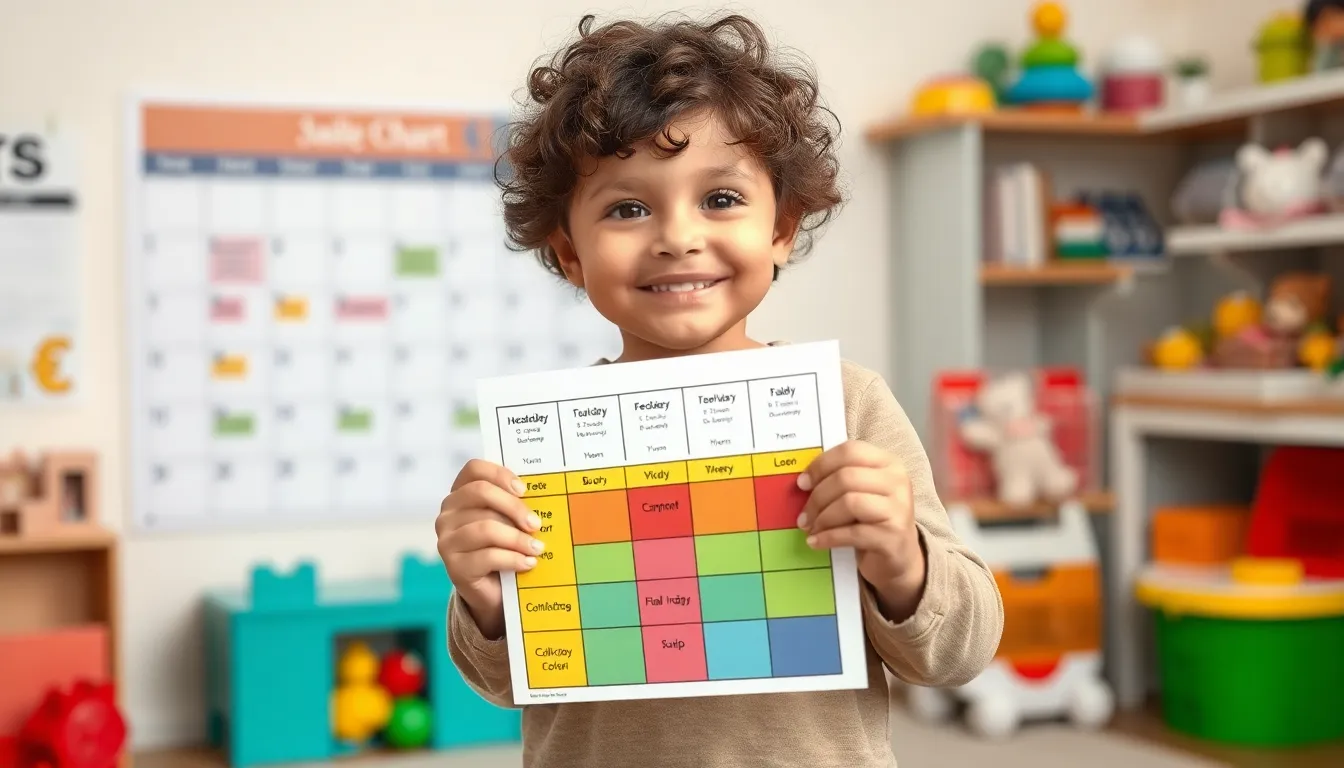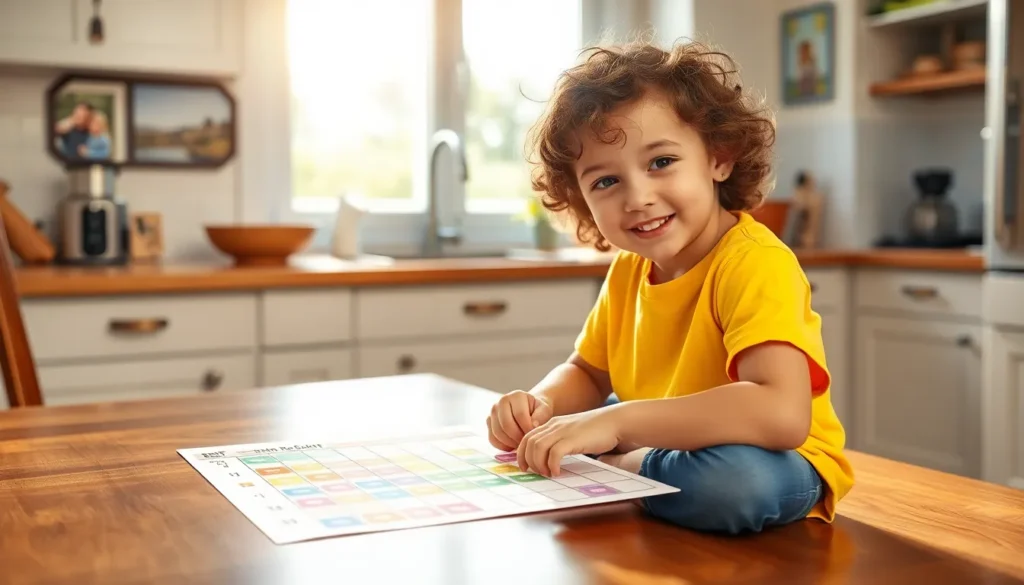Table of Contents
ToggleEstablishing a daily routine can be a game changer for kids and their parents. Routine charts provide a visual guide that helps children understand what’s expected of them throughout the day. These charts not only promote independence but also reduce anxiety by creating a sense of structure and predictability.
In a world filled with distractions, routine charts can be a powerful tool to foster responsibility and time management skills in children. They can easily track tasks like homework, chores, and bedtime, making it easier for kids to take ownership of their daily activities. Discovering the benefits of routine charts can pave the way for a smoother, more organized family life.
Overview of Routine Charts for Kids
Routine charts for kids function as essential tools for establishing daily structure. These visual aids clearly outline tasks, making it easier for children to grasp their daily responsibilities. Routine charts foster independence by allowing children to manage their time and choices effectively.
Routine charts can significantly reduce anxiety. By visualizing their day, children gain reassurance that they know what to expect. This predictability contributes to a stable environment, which is crucial for emotional well-being.
Routine charts also help children develop a sense of responsibility. Tracking tasks such as homework, chores, and family activities cultivates accountability. Kids learn to prioritize and manage their time, skills that benefit them throughout their lives.
Using routine charts encourages positive family dynamics. They promote interaction among family members, as parents and children can review tasks together. This collaboration reinforces communication and strengthens relationships within the family unit.
Benefits of Using Routine Charts

Routine charts offer several advantages that support children’s development and family dynamics. They create structure, foster independence, and enhance overall organization for parents and children alike.
Enhanced Time Management
- Time awareness: Kids learn to estimate and allocate time for tasks, leading to effective daily planning.
- Task prioritization: Routine charts help children identify important tasks, promoting efficiency.
- Consistent schedules: Regular use of charts instills a sense of routine, making it easier for families to manage their time effectively.
Improved Child Independence
- Self-direction: Children gain confidence as they complete tasks independently, nurturing a sense of autonomy.
- Decision-making: Routine charts empower kids to make choices about their daily activities, enhancing their ability to manage time.
- Accountability: Kids take responsibility for their actions and commitments, fostering important life skills that encourage self-reliance.
Better Stress Management for Parents
- Clear expectations: Routine charts provide a tangible outline of daily tasks, reducing anxiety about managing schedules.
- Less parenting pressure: By encouraging children to follow their charts, parents experience relief from constant reminders and supervision.
- Increased family harmony: Improved organization through routine charts promotes cooperation and reduces conflicts over daily responsibilities.
Types of Routine Charts
Various types of routine charts cater to different preferences and needs, enhancing the effectiveness of daily routines for kids. Understanding these types helps parents choose the most suitable method for their children.
Visual Charts
Visual charts utilize images and colors to represent tasks, making them ideal for younger children or those who respond better to visual stimuli. These charts include pictures, icons, or stickers that allow children to connect with tasks more easily. For example, a chart might feature an image of a toothbrush next to “brush teeth,” aiding in comprehension. Visual charts engage children, fostering motivation and enabling them to track completed activities through a fun and interactive experience.
Digital Charts
Digital charts leverage technology, providing an interactive platform for kids to manage their routines. Available as apps or online tools, digital charts can incorporate reminders, timers, and animations that keep children engaged. Parents can customize these charts according to their child’s preferences and needs. For instance, an app may allow kids to unlock rewards by completing tasks, promoting a sense of achievement while helping them develop digital literacy skills. Digital charts appeal to tech-savvy children and make routine management more accessible.
Printable Charts
Printable charts offer a tangible option that parents can customize and print based on their child’s specific routine. These charts can range from simple lists to elaborate designs featuring pictures and colors. Parents can involve their children in decorating or selecting which tasks to include, fostering a sense of ownership. Once printed, these charts can be hung in prominent places, reminding children of their responsibilities throughout the day. Printable charts serve as a versatile tool for establishing routines while accommodating various preferences.
Tips for Creating Effective Routine Charts
Creating effective routine charts requires thoughtful planning and collaboration. These strategies enhance the usefulness of charts, ensuring they meet the needs of children and promote successful routines.
Involving Your Child
Involvement increases a child’s willingness to engage with their routine chart. Encouraging children to participate in the creation process fosters ownership and strengthens commitment. Ask for their input on tasks they want to include, allowing them to express preferences. Collaboratively deciding on the layout—such as colors, images, or symbols—makes the chart more appealing. Regularly review the chart together to assess progress and make adjustments based on the child’s feedback or evolving needs.
Customizing for Individual Needs
Customization ensures the routine chart caters to a child’s unique requirements. Assess the child’s age, developmental stage, and interests when creating the chart. For example, younger children might benefit from visual aids, while older kids might prefer more detailed lists. Integrate specific tasks relevant to the child’s daily life, such as homework, chores, or extracurricular activities. Offering flexibility in the schedule allows the child to adapt their routine, promoting a sense of control and enhancing engagement.
Keeping It Fun and Engaging
Maintaining a sense of fun in routine charts encourages consistent use and participation. Incorporate colorful designs, fun stickers, or reward systems for completed tasks. Set up occasional challenges, such as completing all tasks for a week, to build excitement. Use playful language in the chart’s wording, making it less formal and more relatable. Regularly introduce new elements to the chart to refresh interest, such as seasonal themes or drawings, keeping the routine dynamic and enjoyable.
Routine charts are invaluable tools for fostering independence and responsibility in children. By providing a clear structure for daily tasks, they help kids manage their time effectively and reduce anxiety. These charts not only enhance a child’s ability to prioritize but also strengthen family dynamics through improved communication and collaboration.
Whether opting for visual, digital, or printable formats, parents can tailor routine charts to meet their children’s unique needs. Engaging children in the creation process boosts their commitment and makes routines more enjoyable. Ultimately, routine charts pave the way for organized family life and equip children with essential skills they’ll carry into adulthood.





